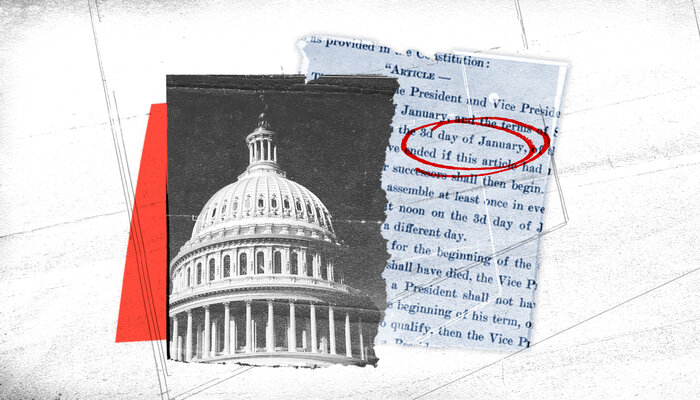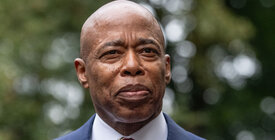
What Happens in a Lame-Duck Session of Congress?
These special postelection meetings have been far more momentous (and controversial) than their name suggests.

Part of
What is a lame duck?
Any meeting of one or both chambers of Congress that takes place after a November election and before the first day of the new Congress’s term is known as a lame duck session. More broadly, the “lame duck” label applies to any outgoing politician, such as presidents serving their final months in office and sitting lawmakers who didn’t win reelection or are retiring.
Though the expression is now common in U.S. politics, its origins come from farther afield. In 18th-century Britain, stockbrokers who didn’t make good on their debts were branded as lame ducks. The term started to be used for outgoing politicians in the 1830s. The first application to a U.S. president appears to have been in 1926, although the current meaning hadn’t yet solidified: Democrats hoped to turn Calvin Coolidge into a lame duck by flipping control of the Senate.
What happens during lame-duck sessions?
Lawmakers use these special sessions to resolve unfinished business from a regular session or deal with specific, urgent issues. Lame-duck congresses have considered a vast array of proposals, such as war-related matters, motions to censure or impeach government officials, and key trade deals.
In recent years, postelection meetings have largely focused on negotiating government budget allocations — a frequently contentious issue. In 2018, Congress struggled to pass its spending bill during the lame-duck session due to a disagreement over President Trump’s request for $5 billion to fund a border wall. This led to the longest government shutdown in U.S. history, which wasn’t resolved until the following Congress’s regular session.
Sometimes, Congress’s only goal during a lame duck is to simply be present. When Congress isn’t in session, the president has the power to veto legislation without giving lawmakers the chance to override it — known as a “pocket veto” — and to fill a vacancy automatically without congressional approval. To prevent these actions, Congress can avoid going on recess or adjourning and instead meet in pro forma sessions — mini sessions held twice a week as a formality to satisfy Congress’s constitutional requirements. These faux meetings sometimes last only a few seconds while a designated senator opens and closes the session.
The Senate took this tactic in 2008 to limit President George W. Bush’s ability to make recess appointments. He had already made 171 recess appointments during his presidency, which was significantly more than his predecessor, Bill Clinton, but not nearly as many as Ronald Reagan’s 232.
How long do lame-duck sessions last?
Congress typically goes on one- to two-month breaks or meets less frequently during election periods. The lame-duck sessions often start in mid-November, shortly after Election Day, and adjourn in late December or early January. On average, they last 37 days, though recent years have trended toward longer sessions. In 2020, for instance, the House’s lame-duck session lasted 49 days, while the Senate’s lasted 56 days. Nevertheless, when considering absences for Thanksgiving and Christmas and the fact that members only meet two or three days per week, these sessions are even shorter in practice.
This wasn’t always the case. The Constitution originally dictated that the congressional term began and ended in March of odd-numbered years. Under this system, the new Congress chosen in a November election wouldn’t start its term until the following March. And, since sitting lawmakers tended to take a break during the summer and reconvene after an election, the last session of Congress, which began in December and ran until March, was always a lame duck.
Many worried that these extended lame ducks offered the opportunity for chicanery by politicians on their way out the door. These fears weren’t without precedent. Historians point to President Benjamin Harrison as an infamous example of a spiteful lame duck wreaking havoc on the country. Harrison campaigned on fire-and-brimstone warnings that electing his opponent would spell economic doom, and in his final months in office, his administration sat idly by while investors panicked and the country descended into the crash of 1893.
Things changed in the 20th century when Sen. George Norris, a progressive Republican from Nebraska, drafted a constitutional amendment that advanced the beginning of the congressional and presidential terms to January rather than March. Congress passed the 20th Amendment in 1932, and it was ratified the following January. Since then, congressional terms start on January 3 of an odd-numbered year and end on January 3 of the following odd-numbered year.
The 20th Amendment’s supporters probably intended to get rid of lame-duck sessions altogether, believing it highly unlikely that lawmakers would be willing and able to meet during the postelection holiday season. Obviously, they were unsuccessful. Congress has held 23 lame-duck sessions following the passage of the 20th Amendment. And since 2000, both chambers have convened after every election without fail for increasingly lengthy lame-duck sessions.
What are some of the most notable lame-duck sessions of the past?
The unique nature of lame-duck sessions has long inspired controversy. Critics argue it is unethical to allow those who lost reelection to continue to legislate, especially since research suggests outgoing members of Congress are more likely to ignore the will of their constituents. There is, however, an important caveat: since most incumbents win reelection and only a few members retire in an average session, only a small percentage of members has the potential to go rogue.
Criticism aside, these sessions have led to many memorable moments in U.S. history. In 1974, Congress saw its most productive lame duck ever, passing 138 pieces of legislation. Its best-remembered actions were dealing with the aftermath of the Watergate scandal. Lawmakers approved the nomination of Nelson Rockefeller as vice president to replace Gerald Ford, who left the post after nine months to replace Richard Nixon as president. And, in a last jab at the former president, Congress rescinded an agreement that would have let Nixon keep ownership of his presidential tapes and papers.
President Bill Clinton’s impeachment was also the product of a lame duck in 1998. The timing was no accident. Some theorize that the Republican-controlled House didn’t want to hold the proceedings in the next regular session because the midterm election had slimmed the party’s majority, potentially risking the success of the vote. The president was acquitted by the Senate the following year anyway.
Another historical highlight happened during the lame duck of 1954, when the Senate voted to condemn Sen. Joseph McCarthy, notorious for his Cold War–era witch hunt of suspected communists and Soviet spies.
Lame-duck sessions are also responsible for significant pieces of legislation that have left lasting marks on modern law and politics. For instance, a year after 9/11, a lame-duck Congress passed the bill that created the Department of Homeland Security. The “Don’t Ask, Don’t Tell” policy, which barred gay, lesbian, and bisexual people from serving openly in the armed forces, was repealed during a lame-duck session in 2010. And the Occupational Safety and Health Act of 1970 — better known as OSHA — was approved during the lame duck. Pivotal to the birth of today’s labor protections, the act gave the federal government the power to establish and enforce health and safety standards for private sector workers.
More from the Explainers collection
-
Territorial Courts, Constitutions, and Organic Acts, Explained
There are five inhabited U.S. territories, each with its own court system and governing documents. -
District of Columbia Courts, Explained
The Washington, DC, court system shares many similarities with state courts, but with a few important caveats. -
Public Campaign Financing and the Indictment of NYC Mayor Eric Adams
The allegations are serious, but fraud in small donor matching programs gets caught.



